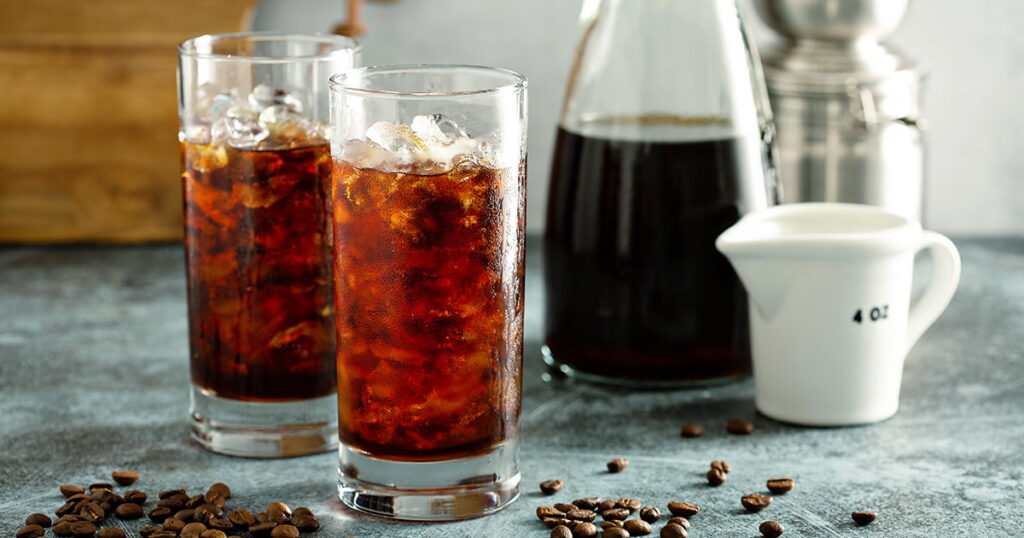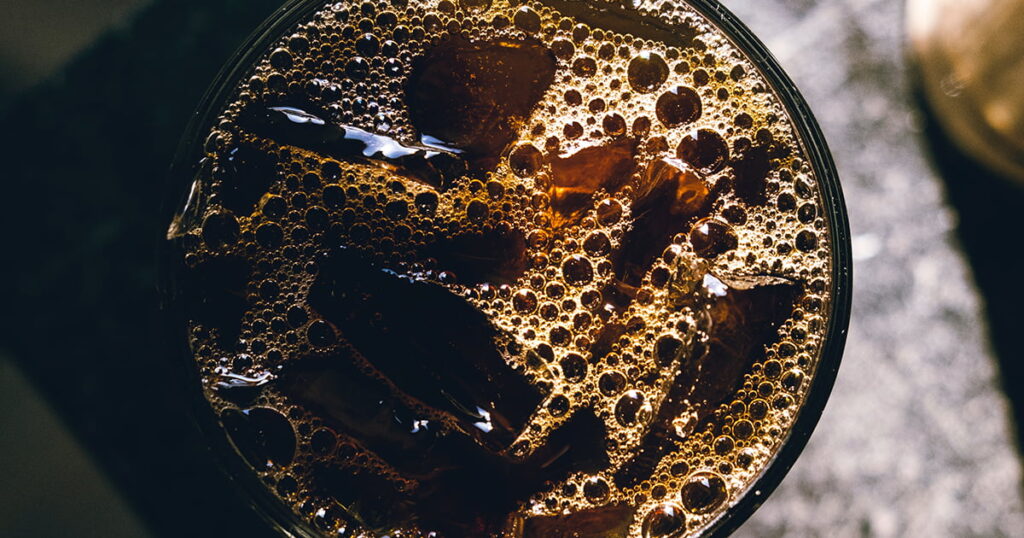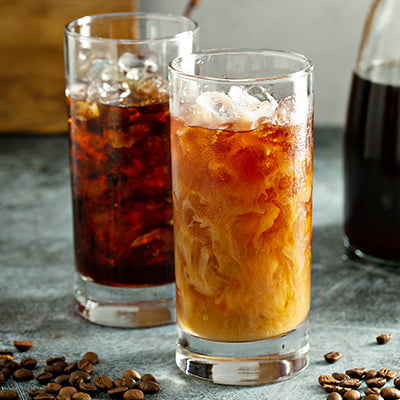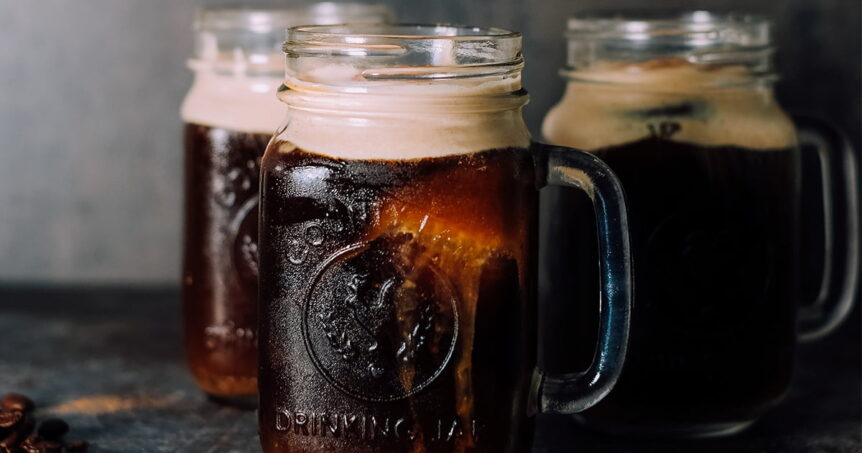Cold brew coffee is simply filter coffee done in a different way. Coffee is steeped in cold water for a couple of hours, utilizing extraction time rather than water temperature to brew the coffee and develop its smoother body, mellow acidity, and natural sweetness.
Both true coffee lovers and infrequent coffee drinkers have definitely heard of the cold brew – and it’s all the rage for a reason. It offers a whole different experience from the usual iced black coffees made using drip brewers and espresso machines because of the unique way it’s prepared. In this article, we will dive into the history of cold brew, how it’s made, and even some fun variations to try out.
| Cold Brew Coffee | |
|---|---|
| Main Ingredients: | Cold Water, Ground Coffee |
| Serving Temperature: | 3–7 °C– (38–45 °F) |
| Place of Origin: | Kyoto, Japan | Caffeine per Serving (mg): | 26 milligrams of caffeine per fl oz. A cold brew’s caffeine content is determined by its brewing ratio and concentration. A 16-oz. cold brew has about 200 mg of caffeine. |
What Is Cold Brew Coffee?
The term cold brew is used to describe the method of how the beverage is prepared: with the use of cold water instead of hot. More specifically, this is done by steeping coarsely ground coffee beans in cold water for an extended period of time. Its flavors and character is derived from the slow extraction process and longer brewing time and not from the temperature of the water that is exposed to the coffee. This results in a smoother and mellower coffee concentrate that can be served over ice or mixed with water or milk to create a refreshing coffee treat.
What Is A Cold Brew Coffee Made Of?
In making cold brew concentrate, you only need your ground coffee and cold water. The ground coffee is steeped in cold water for a prolonged period of time of about 12 to 24 long hours. Then the grounds are filtered out, leaving behind a concentrated coffee solution that can be diluted with more water to create a refreshing and smooth iced coffee.
Unlike traditional hot brewed coffee that is brewed quickly with hot water, cold brew is brewed slowly with cold water, which results in a different flavor profile. The end cup tends to be less bitter and acidic and has a sweeter, smoother taste. This is mainly because cold water extracts fewer bitter compounds during the process than hot water does. Nevertheless, it still retains the desired amount of caffeine and flavor characteristics.
What kind of beans or grounds are used for a good cold brew coffee?
Cold brew coffee can be made with a variety of coffee beans, but it is often recommended to use a medium to dark roast with a strong flavor profile, such as Colombian or Ethiopian. Latin American coffees contribute to the mild chocolate notes, while African beans are the best variants for making refreshing iced coffees. The coffee-to-water ratio can vary depending on personal preference, but a common ratio is one part coffee to four parts water.
Overall, cold brew coffee is a delicious and refreshing alternative to hot coffee. It has become increasingly popular in recent years because it’s easy to make and offers unique, clean flavors.
Why Should You Cold Brew Your Coffee?
Cold brewing coffee offers several benefits compared to traditional hot brewing methods. Here are some reasons why you might want to try cold-brewing your coffee:
- Convenience: Cold brew coffee can be made in advance and stored in the refrigerator for a couple of days. This provides a very convenient way to enjoy coffee throughout the week.
- Versatility: With its smooth and sweet qualities, cold brew coffee can be consumed on its own or used as a base for a variety of coffee drinks. You can use concentrated cold brew in handcrafting iced lattes, frappes, and nitro cold brews.
- Cost-effective: Making cold brew coffee at home is less costly than purchasing pre-made iced coffee or going to a coffee shop.
- Less acidity: Cold brew coffee is actually less acidic than hot brewed coffee, which can be gentler on your stomach and teeth.
- Smooth taste: Cold brewing extracts fewer of the bitter compounds and oils from the coffee beans, which will result in a sweeter, smoother cup of coffee.
Generally, cold brew coffee is an excellent option for people who prefer less intense coffees and a more refreshing and smoother tasting experience.
The History Of Cold Brew Coffee

In recent years, cold brew coffee has continued to grow in popularity and has become a staple offering in many coffee shops and cafes. In fact, many coffee companies are now offering pre-packaged cold brew coffee or cold brew coffee concentrate that coffee lovers can easily enjoy at home.
So, where did this trendy beverage originate from? Who should we thank for inventing such a delicious coffee recipe?
Who invented cold brew coffee?
According to the legend, Japanese coffee merchants from Kyoto developed the method of brewing coffee using cold water. This process was made to keep coffee fresh without using any heat. Eventually, this type of preparation became known as Kyoto-style or Japanese iced coffee.
Where is the cold brew coffee from?
The exact origins of cold brew coffee are uncertain. However, it is believed to have originated in Japan in the 1600s. One theory suggests that the unique brewing method was learned from Dutch traders.
During the 1960s and 1970s, cold brew coffee made its way to the United States. However, it only became a hit in the coffee industry during the 2000s–a mainstream trend in many coffee shops and roasters in different parts of the world.
How Much Caffeine Is In A Cold Brew Coffee?
The amount of caffeine in a cold brew coffee may vary. A few factors are the type of coffee beans used, the brewing method, and the coffee-to-water ratio. On average, cold brew coffee has higher caffeine concentration than regular hot brewed coffee or a single espresso shot. The best-known reason for this is that the slower brewing process allows for more caffeine to be extracted from the coffee beans. However, the overall caffeine content of the final drink may also be inconsistent time after time, as cold brew coffee is typically diluted with more water before consumption.
In general, 26 milligrams of caffeine is present for every fluid ounce of cold brew coffee. This means that every 16-ounce serving may contain up to 200 milligrams of caffeine. With that, it’s important to keep in mind that individual tolerance to caffeine is different from one person to another. So, if you are sensitive to caffeine, you may want to limit your intake of cold brew coffee or opt for a decaf version.
How Many Calories Are In A Cold Brew Coffee?
A regular-sized black cold brew coffee typically contains between 0 and 5 calories, making it a great option for those looking to limit their calorie intake. However, if you add milk or sweeteners to your cold brew coffee, the calorie count can increase significantly.
For example, adding a splash of whole milk (2 tablespoons or 30 ml) to your cold brew coffee can add approximately 20 calories, while adding a tablespoon (15 ml) of simple syrup or honey can add around 60 calories.
How To Make Cold Brew Coffee

Image credit > Matt Hoffman from Unsplash
Cold brewing is probably one of the easiest brewing techniques anyone can do at home. It doesn’t require any fancy brewing equipment or pulling a shot of espresso. All you need is a big container, a filter, your coffee, and cold water.
Here is a step-by-step guide on how to make a good cold brew coffee at home.
- Choose the right coffee: Start by choosing a high-quality coffee bean that you enjoy. Consider using a medium or dark roast for a bolder, richer flavor.
- Grind the coffee: Grind the coffee beans coarsely to ensure the best extraction. You can use a coffee grinder or ask your local coffee shop to grind the beans for you.
- Mix coffee and water: Mix the grounds and water in a large jar or container. A good coffee-to-water ratio is 1:4 or 1:5, which means one part coffee to four or five parts water.
- Stir and let it steep: Stir the mixture to ensure the coffee is evenly saturated, and let it steep for 12 to 24 hours. For a stronger brew, steep for longer.
- Strain the mixture: Once the steeping process is complete, strain the mixture through a fine-mesh sieve or a cheesecloth to remove the coffee grounds. You can also use a French press or a cold-brew coffee maker.
- Dilute and serve: Dilute the concentrate with water or milk to your desired strength, and serve over ice. You can also add sweeteners or flavorings if desired.
- Store leftovers: Store any leftover cold brew concentrate in the refrigerator for up to a week.
With these steps, you can enjoy a delicious and refreshing cold brew coffee from the comfort of your own home.
How to Serve Cold Brew Coffee
Cold brewing yields concentrated black coffee, which is typically mixed with more water in a 1:1 ratio. The diluted end product is usually served in a variety of ways depending on your preferences.
The simplest way to drink this coffee is by pouring it over a glass of ice. Cold brew is also enjoyable with a splash of milk or cream on top. If you’re more of a sweet-toothed drinker, adding simple syrup, honey, or other flavorings may be something you would prefer. More innovative versions include blending cold brew coffee and infusing it with nitrogen.
Overall, everything lies on the consumer’s personal preference. Experiment with different ways of serving and enjoy your refreshing and delicious cold brew coffee.
How to store cold brew coffee
Storing your cold brew coffee properly is important to preserve its flavor and freshness. Here are some tips to ensure that your cold brew coffee keeps fresh and flavorful!
- Keep it refrigerated: Once you have made your cold brew coffee, transfer it to a clean, airtight container and store it in the refrigerator. This will help prevent the growth of bacteria and preserve the flavor.
- Keep it sealed: Make sure the container is tightly sealed to prevent air and moisture from getting in. You can use a mason jar, a pitcher with a lid, or a specially designed cold brew coffee container.
- Use it within a week: Cold brew coffee can be stored in the refrigerator for up to a week, but it is best to consume it within the first few days for optimal flavor.
- Dilute as needed: When you’re ready to serve your cold brew coffee, dilute it with water or milk to your desired strength. Do not dilute the entire batch at once, as this can reduce the flavor and freshness.
- Avoid freezing: Avoid freezing your cold brew coffee, as this can alter the flavor and texture.

Equipment
- Large jar or pitcher with cover
- Mesh sieve or cheesecloth
- Serving glass
Ingredients
- 1 cup of coarsely ground coffee beans
- 4 cups cold water
- Ice cubes
Instructions
- In a large jar or pitcher, combine the coffee grounds and water.
- Stir gently until the coffee is fully saturated.
- Cover the jar or pitcher and let it sit at room temperature for 12-24 hours.
- After the steeping time, strain the coffee through a fine-mesh sieve or cheesecloth into another container.
- Store the cold brew coffee in the refrigerator until ready to serve.
- To serve, dilute the cold brew coffee with equal parts room temperature water to your desired taste.
- Add ice, serve, and enjoy!
Cold Brew Coffee vs. Iced Coffee
Cold brew coffee and iced coffee are both two very popular cold coffee beverages. While the two coffee drinks look very alike, they have major differences in flavor and preparation methods.
Cold brew coffee is made by steeping coffee grounds in cold water for an extended period. The slow extraction process which lasts from 12 to 24 hours produces a smooth, less acidic coffee with a full-bodied flavor.
On the other hand, iced coffee is made by brewing hot coffee and then cooling it down with ice. This method produces a more traditional coffee flavor that is brighter and more acidic than cold brew.
Cold Brew Coffee vs. Cold Brew Concentrate?
The main difference between cold brew coffee and cold brew concentrate is their strength and intended use. The concentrate is much stronger in taste and requires further dilution because of its higher ratio of ground coffee to water. On the other hand, cold brew coffee is a ready-to-drink product and can be consumed instantly.
Basically, cold brew concentrate is what you get when you steep coffee in cold water for 12 to 24 hours. Once the brewing is done and the coffee is strained, you can dilute the concentrate in equal parts water and serve this with ice–and now you have a glass of cold brew coffee!
Frequently Asked Questions
How long does cold brew coffee last in the fridge?
Cold brew coffee can last in the fridge for up to a week if stored properly in an airtight container.
How much caffeine is in cold brew coffee?
A glass of cold brew coffee generally has more caffeine than a cup of brewed coffee or a shot of espresso. An average 16-oz serving will have approximately 200 mg of caffeine.
What to add to cold brew coffee?
Many cold brew fans love to experiment with their favorite coffee beverages by adding milk, cream, and sugar. Flavored variants such as dark caramel and French vanilla cold brew coffee are also extremely popular.
What is special about cold brew coffee?
Cold brew is basically a very unique type of brewed coffee with a slow extraction process. This results in a smoother, less acidic cup with sweeter flavor notes than regular brewed coffee.
Is cold brew coffee stronger than regular?
Cold brew coffee is typically stronger in terms of caffeine due to its concentrated brewing process. However, it’s less bitter and smoother when it comes to flavor characteristics.
Can you make a cold brew with regular coffee?
Yes, you can make a cold brew with regular coffee. However, it may not produce the same flavor profile as using coarse, high-quality coffee grounds.
Why is cold brew better for your stomach?
A cup of coffee has plenty of acidic compounds, which can irritate the digestive system. Cold brewing diminishes these compounds as it is prepared using cold water and extracted more slowly.
What are the pros and cons of cold brew coffee?
There are several pros to opting for cold brew coffee which include a smoother and sweeter cup, longer shelf life, and a more cost-effective preparation method. On the other hand, some cons may be the higher caffeine and longer brewing time.
Is cold brew coffee anti-inflammatory?
Major healthy antioxidants found in cold brews include caffeine, cafestol, chlorogenic acid, and melanoidin. These compounds have impressive anti-inflammatory properties.
Is cold brew coffee good for weight loss?
Cold brew coffee’s potentially lower calorie and sugar content may help you in your weight loss journey. Rather than consuming milk-based and flavored iced coffees, opt for a cup of plain black cold brew coffee.
Wrapping Up
Today, cold brew coffee has become a popular alternative for coffee fans, especially during the warmer months. With its smooth, refreshing taste and lower acidity, cold brew coffee has become a beloved beverage for coffee drinkers around the world. Not only does it promise a delicious cup, but it’s also very easy and convenient to make–minus the coffee makers and espresso machines!
Main image credit > Rinck Content Studio from Unsplash

